


|
 |
|
|
#1 |
|
Registered Member
Join Date: May 2004
Location: Surfers Paradise, Australia
Posts: 568
|
Use Ciprofloxacin to Save Your Ricordea Garden! (Yuma Bacterial Infections)
I recently started a thread HERE after I was lucky enough to purchase a rock with two hot pink yuma and a few pups. Within two weeks both pinks developed the dreaded bacterial infection that began spreading throughout my yuma garden. Ciprofloxacin (Cipro) saved me from losing my entire collection!
Time and time again there are accounts that after adding a new Ricordea yuma (especially hot pink) to an existing collection, that the new addition has slimed up from a bacterial infection that eventually spread throughout the collection, killing all Ricordea yuma in the tank. Other write ups I read have concluded that nearly every standard treatment option (Melafix Marine, Iodine, Furan 2 and even some unspecified human antibiotics) has been tried with no success. It was suggested by el_pinguino, to look to antibiotics as other RC Members had been successfully treating sick Gigantea Carpet Anemones with Cipro This is a broad spectrum antibiotic with promising results. Cipro was ideal for the following reasons: • It is readily available in the US or available from a vet with a prescription • It dissolves easily in water • When administered in water, light breaks Cipro down rapidly (half life of about one and a half hours as evidenced HERE)* *Please expose treated water that is to be discarded to several hours of light before discarding to keep active antibiotics from entering the water system and potentially contributing to antibiotic resistant bacteria. **DO NOT DOSE CIPRO IN ANY TANK OTHER THAN A HOSPITAL TANK AS IT WILL DESTROY THE BACTERIA THAT MAKE UP YOUR BIOLOGICAL FILTRATION** How am I sure this treatment works? At best, this treatment has cured an infected (orange rimmed blue) Yuma in the early to middle stages of infection but at the very least, it has successfully halted the movement from infected yuma to healthy yuma in the same five gallon tank. 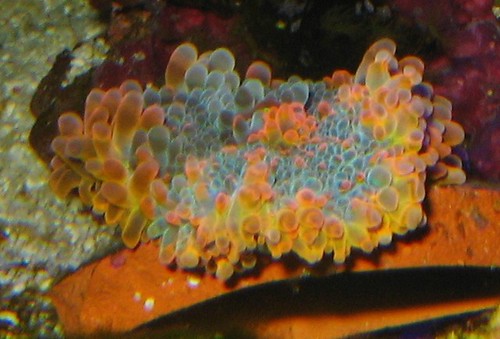 All of my yuma were exposed to the infection in the display tank. Two new pink yuma and two established yuma perished as a result of the infection before the rest of the Ricordea were moved to the hospital tank. The orange rim blue yuma was showing the early stages of infection and was separated from its pups. The foot of this one was damaged in the process but left in the display for several days before moving for treatment. After it was handled, the slime was brown, not white, so it appeared to be infected with a foot injury to boot. My favorite, healthy yuma, were moved to a hospital tank and two days later Cipro treatment began. 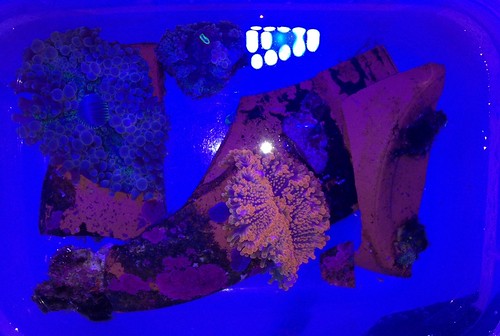 The rest of the collection was moved to the same hospital tank approximately 10 days later and treatment continued. A few days later a green with pink base Yuma became contracted, the blue orange yuma remained contracted and these two were moved to a separate container within the hospital tank with some treated water added every night. The dosage was probably not enough and the green with pink base got worse, showed some slime, and perished. Once the slime appeared on the green yuma, the orange/blue yuma was returned to the main hospital tank. It was still partially contracted but looked slightly better. Ten more days of diligent nightly dosing later, all of the remaining yuma looked normal and healthy once again. They have all been in the new, un-treated, tank for nine days now with no signs of re-infection. Identify the infection First signs of infection – A fully expanded and healthy looking Yuma will contract and stay contracted from that day forward. ALL of my infected yuma did this. They all remained completely contracted for approximately three to five days before showing secondary signs of infection. *Please note that contraction and expansion is normal with Ricordea and you should not start treating with Cipro at the first sign of contraction. Many of my yuma repeatedly contracted and expanded for a few months before they finally settled into their new homes. The difference that I noticed was that an infected yuma stayed in a constant state of contraction for several days before the infection progressed. Below are pictures of the same pink yuma contracted and expanded for comparison.  Secondary infection – After staying contracted for three to five days, the infected yuma began secreting a stringy, brown slime. In the midst of transferring my collection to the hospital tank, many of the yuma slimed up as expected upon handling. Normal slime is a white color, and they all had some white slime present except for my blue/orange yuma which was contracted. The blue/orange yuma had a brown secretion which is what lead me to believe it was infected.  Brown slime is just starting to be excreted from the edges of this pink yuma:  Final stages of infection – The yuma will display copious amounts of globular brown slime along its outermost edges, on the base or around the mouth. The ‘hole in the mouth’ that has been observed by others with infected Ricordea may now be visible; a Yuma at this stage is likely lost. I did not have another tank to try and properly treat a yuma in this late stage of infection. Most of the brown slime had been removed from these pink yuma in hopes that keeping the Ricordea clean would allow it to heal and recover; however, they were both lost. 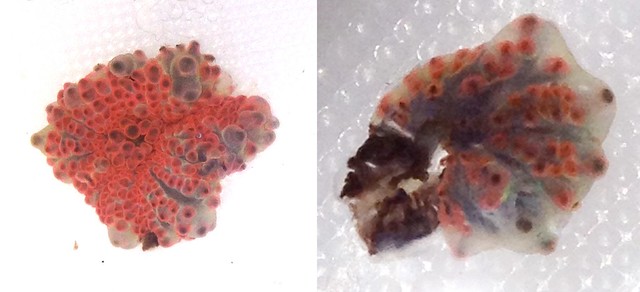 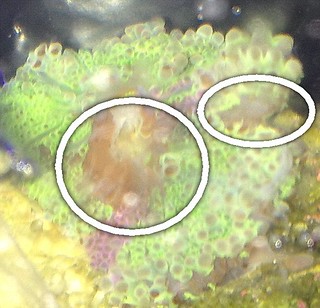 Treatment Not long after the first pink yuma had entered the later stages of infection, the second pink yuma became infected. Just before the second pink yuma was completely gone, a green and purple yuma that had been in my tank for 8+ months also became infected. A few days later, another green yuma of 6+ months became infected. At this point I decided to remove all remaining Ricordea from the display tank and start treating them with Cipro. I acclimated as normal into a hospital tank ensuring NONE of the display tank water was transferred. I rinsed all Ricordea with hospital tank water again before adding to the hospital tank. Every night when the lights turned off, I used a dosage of approximately one 250mg tablet of Cipro per ten gallons (~forty litres) of hospital tank water. I used one half of a 250mg tablet for five gallons (~ twenty litres) of water. You can hold the tablet in front of a power head or add to a small container of hospital tank water and let it dissolve for a few minutes. I chose the latter and crushed up any remaining pieces that didn’t completely dissolve the best I could. Then, I poured it in front of a power head to distribute the antibiotic throughout the tank. There was always undissolved residue that eventually started to accumulate on the rocks and other surfaces of the hospital tank. I did not notice any adverse effects from this. As this antibiotic will break down with exposure to light, I dosed when the lights were out and I turned off all other lights in the room. You could easily cover the hospital tank with a heavy blanket to ensure it is dark when treating to give the medication as long as possible to do its job. **I did all water changes and tank transfers several hours into the light cycle in an attempt to break down the antibiotic as much as possible before discarding.** I did a fifty percent water change every two to three days in the beginning but stopped after three water changes since I was not feeding the tank and nothing was decaying. My girlfriends mother is a pharmacist and recommended that I transfer the Ricordea to another hospital tank because bacteria can create a film on the inside of the tank and remain present in the water. This sounded like a good idea just in case the bacteria I was trying to eliminate was still present and growing in the current tank. After two weeks of treatment, I transferred all of the Ricordea to a new hospital tank, again taking care to ensure none of the original water went into the new hospital tank. I cleaned the original tank with vinegar and transferred all of the Ricordea back to the original tank two weeks later. I made the mistake of adding the blue/orange Ricordea, that was exposed to an infected yuma, back to the hospital tank because I didn’t have enough heaters to start another hospital tank. That makes me more confident in the treatment since none of the remaining yuma became infected. 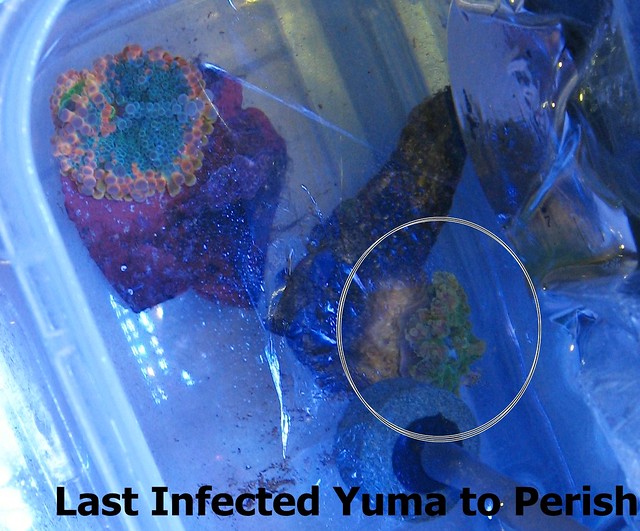 I dosed the hospital tank with the surviving Ricordea for another ten days after the blue/orange Ricordea was added back. My girlfriends mother suggested treating the Ricordea for two to four weeks to kill as much of the bacteria as possible but this was just and educated suggestion. Some of my Ricordea were in the hospital tank, with nightly dosing, for five weeks and the blue/orange Ricordea only had ten days of 'full strength' dosing after being exposed to an infected Ricordea. It has been nine days since all Ricordea have been in the new, untreated, tank with no signs of infection. Quarantine New Ricordea Ricordea do not take up much space and are fairly hardy if given ‘good’ conditions so why not setup a basic quarantine tank and observe them for four weeks? They only need a small tank with a heater, power head and a bit of light(a large CFL would probably work for four weeks). Is it really worth the risk of losing your $1000+ Ricordea garden because you did not want to spend $30-40 on a quarantine setup? I will never add a new Ricordea to my established garden without a proper quarantine again! 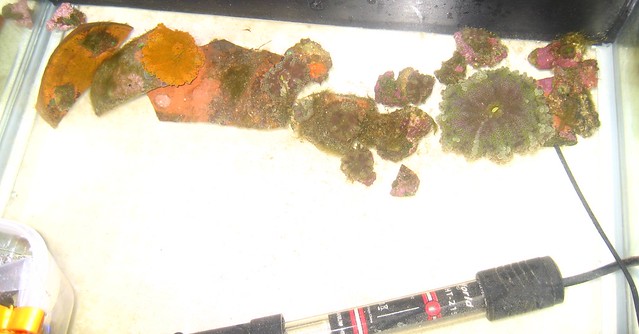 Here is the orange rimmed blue Ricordea and my first and largest Ricordea now: 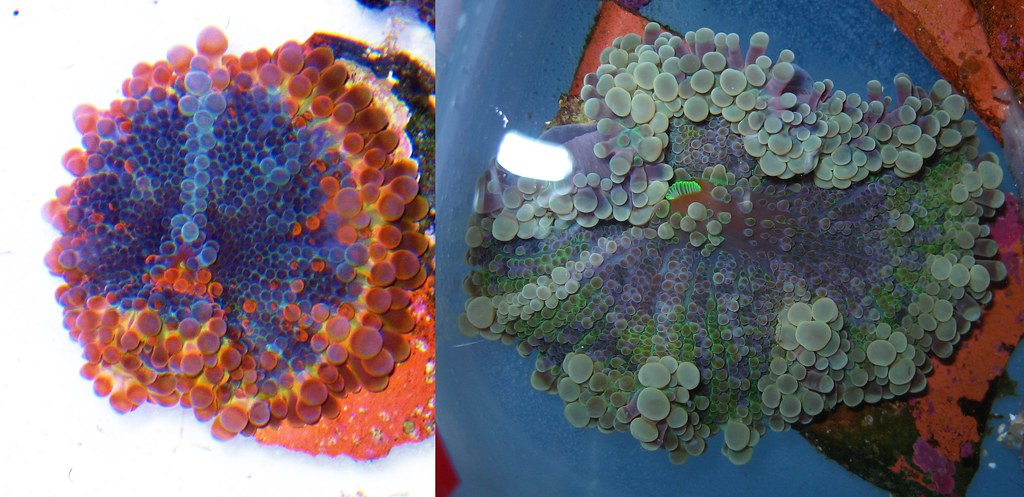 Conclusion • I realize that is has only been nineteen days since the last sign of infection but once the infection started, a new yuma would begin showing symptoms every four to five days so this is a good sign. • There were no noticeable negative effects of a long treatment (five weeks) other than the white residue collecting on the rocks. • I was not able to determine if this treatment would save a Ricordea that was showing considerable brown slime and tissue damage but it did help a wounded and infected Ricordea make a complete recovery instead of progressing into the further stages of infection and likely death. • I have no idea of how long a bacterial strain like this will survive in the display tank without any Ricordea to infect. • Photo acclimation may have been a factor that contributed to the initial infection of my new pink yuma but I was told they were at the LFS for three weeks and they were about two thirds of the way down in a tank growing sps when I purchased them. I placed them on the bottom of my tank, about two feet from my leds and they are only turned up to about twenty-five percent. Either way, the infection did spread to healthy yuma that had been settled for many months. • Please quarantine all new Ricordea for at least four weeks just to make sure they aren't infected. • With the exception of the two new hot pink Ricordea and a few green/purple Ricordea, my collection is alive and well. One of the hot pink pups is just starting to develop some bright color so I consider this a huge success after all the other horror stories I have read. Good luck and save those Ricordea! |
|
|

|
|
|
#2 |
|
Registered Member
Join Date: May 2012
Posts: 325
|
Wow -- great post. Thanks so much for the info. It will be interesting to hear people's opinion on how long the DT will need to remain 'ricordea fallow' before they can be reintroduced.
|
|
|

|
|
|
#3 |
|
Registered Member
Join Date: Jul 2008
Location: plantation Fl
Posts: 1,336
|
Wow what a great write up. Thanks for the info.
|
|
|

|
|
|
#4 |
|
Reef Fanatic
Join Date: May 2012
Location: Las Cruces, NM
Posts: 703
|
I'm glad that we atleast have some limited success in trying to keep Yuma Ricordea's alive from this awful bacterial infection. Thank you for trying/risking your Yuma's and finding a possible solution for the rest of us. I know I appreciate you and have a little more confidence in buying another Yuma in the future because of your efforts. Again, Thank You.
|
|
|

|
|
|
#5 |
|
ReefOG
Join Date: Apr 2007
Location: Morton grove, IL
Posts: 3,976
|
I seen the symptoms described in this thread many many times and killed thousands of dollars work of Yuma. excited about this and will try again to build up my Yuma collection. thanks for the write up. will update my experience also here.
__________________
-~adrian~- LETS TRADE YUMAS Current Tank Info: Glass box. |
|
|

|
|
|
#6 |
|
Registered Member
Join Date: Jul 2010
Location: San Jose, CA
Posts: 1,149
|
Hmmm. I've never experienced what you're describing... I have several yumas in my tank, and whenever I get a new yuma that starts to melt, the infection does not spread to other yumas, or anything else for that matter.
Also in my experience, it isn't necessarily connected to color, I have a pink yuma that is doing well in my tank... What it seems to be, is whether it was aquacultured or wild caught. Wild caught yumas seem to die readily, whatever color it is. My pink yuma, is aquacultured. My other yumas, orange and blue, and the yellow gold green ones (often called sunset) ones are also aquacultured. All the other yumas I've ever gotten have melted on me. Did you save any of the new yumas that you introduced that started to melt? That to me is the real question. Also how long have they been in your tank since treatment? I have a standing rule that I will not think of any yuma as "surviving" until three months in a tank, since new yumas can sometimes last a month or so without any obvious signs of infection, then rapidly decline to the dreaded infection. So if the new ones have survived treatment and are improving ( already a major step!) I would be curious if they survive for a month or longer. Thanks for the work you're doing! I don't mean to sound negative, I'm just always a little skeptical.
__________________
90 gallon mixed reef XPS1000SSS skimmer, 2 radions gen 1, tunze osmolator w/ kalk dispenser, 70 lbs pukani, mp40w x2; 1 tomini, 1 clown 2 mandarins. Vinegar dosing, and micro bubble scrubbing. |
|
|

|
|
|
#7 | ||||
|
Registered Member
Join Date: May 2004
Location: Surfers Paradise, Australia
Posts: 568
|
Thanks guys! Ricordea have to be my favorite species of all the creatures in my tanks and I hope this helps us to keep many more of them alive if they are exposed to this infection.
Quote:
Quote:
Quote:
Quote:
"I did not have another tank to try and properly treat a yuma in this late (final) stage of infection." And "I was not able to determine if this treatment would save a Ricordea that was showing considerable brown slime and tissue damage but it did help a wounded and infected Ricordea make a complete recovery instead of progressing into the further stages of infection and likely death." The blue/orange Ricordea being infected was my best guess based on the fact that it was showing signs of contraction prior to the foot injury and that the slime was brown(not white) when disturbed a few days after the injury. The brown slime may have been from the injury, that I do not know, but the injury would have made this yuma much more susceptible to the infection spreading through the collection. This injured yuma was also kept with a known infected yuma, in 1 litre of water for several days with low doses of Cipro and added back to the tank with the stronger dose later but still has completely recovered. Also "I realize that is has only been nineteen days (twenty now, ten since treatment has ceased) since the last sign of infection but once the infection started, a new yuma would begin showing symptoms every four to five days so this is a good sign." I was going to wait another week or so but a member of a local Facebook Group looked to have an infection that was on its way to killing its second yuma so I decided to post this early. This looks to have saved most of my collection but has not treated a melting yuma. My hope is that this treatment will help others at least save the majority of their collections if not a melting yuma. If I had more tanks setup, more patience and picked up Cipro sooner, I would have treating the infected pinks at the first sign of brown slime or even tried cutting the healthy part away to treat that. Hopefully the next person to be faced with this infection can take some of these actions and post their results. |
||||
|
|

|
|
|
#8 |
|
Registered Member
Join Date: Jul 2010
Location: San Jose, CA
Posts: 1,149
|
Oh, okay. I got a little lost in reading the OP. It was a little hard to discern which were new yumas and which were yumas you had existing previously.
How long have your other yumas (not new) been in the tank for? I'm assuming they are all yumas too, since you're in Australia. There aren't a lot of aquacultured yumas in the states either. Really just a handful of color morphs, that really aren't up to snuff as some of the amazing wild colors. Orange, green, and sunset are the ones that are aquacultured. I wonder if when we get our wild yumas, if a dose of Cipro will help them survive? Or if there is a better way to acclimate them to our tanks that will keep the stress low? The general theory is that the stress from collecting to store to customer is just too much for wild caught yumas do go through.
__________________
90 gallon mixed reef XPS1000SSS skimmer, 2 radions gen 1, tunze osmolator w/ kalk dispenser, 70 lbs pukani, mp40w x2; 1 tomini, 1 clown 2 mandarins. Vinegar dosing, and micro bubble scrubbing. |
|
|

|
|
|
#9 |
|
Registered Member
Join Date: Jan 2013
Location: San Jose, California
Posts: 116
|
Excellent news!
My guess is that you can never really eliminate the culprit bacterium in the display tank. Unlike parasites that you can starve out, bacteria can remain dormant indefinitely. They should be able to defend themselves against further infection if fully back to health. |
|
|

|
|
|
#10 | ||
|
Registered Member
Join Date: May 2004
Location: Surfers Paradise, Australia
Posts: 568
|
Quote:
Im sure it is a small percentage of yuma that actually get this infection as there are so many yuma collections in this country. But I will inspect every new yuma for any signs of damage and watch to see if it stays contracted for any extended period of time. I dont think it would hurt to treat a new yuma with Cipro if it showed any possible signs of infection. If it generally takes 2 weeks or so for the infection to show, maybe we can start dosing Cipro in the QT tank immediately after purchase and keep the bacteria from infecting the new yuma. Quote:
I hope they can defend themselves from the infection but healthy yuma were infected in the first place. Im really not sure what to do but for now, my display tank remains Ricordea free. |
||
|
|

|
|
|
#11 |
|
Registered Member
Join Date: Feb 2013
Location: Endicott, NY
Posts: 909
|
Wow, I am sooooooo glad to hear this after my big loss of my pink yuma couple hundred dollars worth last year. Thanks so much!!!!!!!

__________________
90 gallon Fish only tank Current Tank Info: 90 gal tank AquaMax skimmer LED EchoTech Gen 3 lights Gyre150 RO/DI water |
|
|

|
|
|
#12 |
|
Registered Member
Join Date: May 2012
Posts: 325
|
|
|
|

|
|
|
#13 |
|
Registered Member
Join Date: May 2004
Location: Surfers Paradise, Australia
Posts: 568
|
I have not added any back to my DT but I might try a plain one after I get back from my upcoming vacation. I will try and take some more pictures soon as all of the yuma that survived are still alive and doing very well, many have also began reproducing again.
|
|
|

|
|
|
#14 |
|
Registered Member
Join Date: Apr 2013
Location: Richmond, CA
Posts: 224
|
Interesting read. Thank you for sharing.
|
|
|

|
|
|
#15 |
|
Registered Member
Join Date: Sep 2007
Location: NE Ohio
Posts: 1,819
|
I had to treat my recent addition. When I treated the Yuma I noticed it's mouth never closed. Is this common?
This is my second wild Yuma . The first ones I bought just slowly disintegrated away as I noticed pieces floating away in the tank. Have you noticed the same thing with yours or just the white tissue.
__________________
Antonio H Magnificia or bust. |
|
|

|
|
|
#16 |
|
Registered Member.
Join Date: May 2013
Posts: 65
|
Great writeup. I personally would have started with amoxicillin then see how the yumas reacted to that. If no progress was made, I would have went with the big gun, Cipro. Also, I have yet to find any evidence that supports that Cipro breaks down in light. I have read that it's effectiveness lessen the effectiveness of the pill. If it was light sensitive, it would be prescribed on brown bottles or light-tight containers with a warning label. A side effect of Cipro is that it causes light sensitivity in patients, though.
|
|
|

|
|
|
#17 |
|
Registered Member
Join Date: Apr 2014
Location: Bergen County, NJ
Posts: 1,033
|
Gonna follow along....I love Yumas and want to start a garden. In your opinion...how long would you recommend a tank be up,and running before adding a Yuma??
|
|
|

|
|
|
#18 |
|
Registered Member
Join Date: May 2004
Location: Surfers Paradise, Australia
Posts: 568
|
Its been nearly 4 months since I started this thread and I just wanted to post an update. All of the yuma are still alive and doing well. My massive orange yuma has even split off 3 pups in that time so Im very happy to say the least. There are several more (mostly purple and green) above where I cropped the photo but these are my favorites.
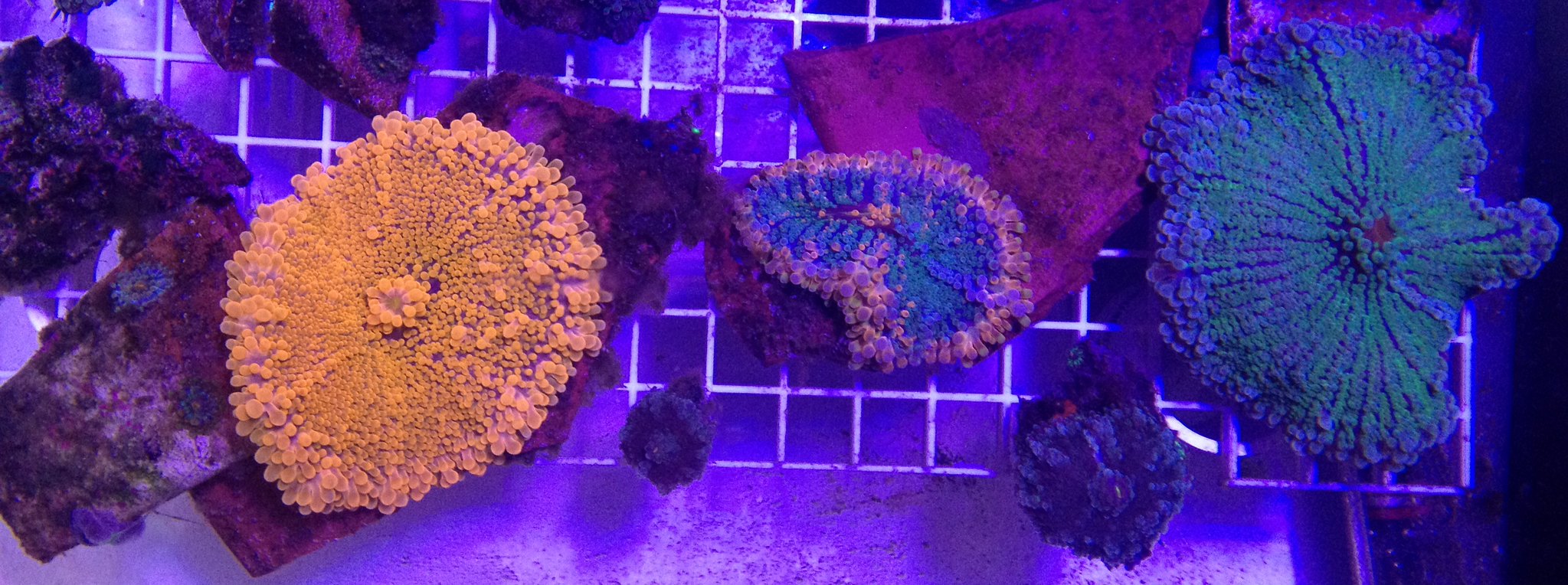
|
|
|

|
|
|
#19 | |||
|
Registered Member
Join Date: May 2004
Location: Surfers Paradise, Australia
Posts: 568
|
Quote:
Quote:
My Cipro was in a foil pack and the pharmacist said light degradation isn't a concern when humans are prescribed this because it is taken orally and light will not penetrate skin to affect it. In the article I linked it says "Initial laboratory experiments showed that cipro rapidly photodegraded (t 1/2 ∼ 1.5 h) with numerous photodegradation products being noted when POC levels were low." When particulate organic carbon, or POC, are low, then it has a half life of about 90 minutes. Hopefully after being exposed to a normal light cycle during the day it has broken down enough to be ineffective but not 100% on that. Quote:
|
|||
|
|

|
|
|
#20 |
|
Registered Member
Join Date: Jul 2010
Location: San Jose, CA
Posts: 1,149
|
Good to hear they're doing well! Let us know if you use the Cipro again, and what the results are. As you know, I started out skeptical, but only because I'm highly cautious generally about new treatments/techniques. But if this far out things are still good, I might be encouraged to try this. I've really avoided buying and even looking at yumas because if how much I've sunk into yumas in the past. But I'm going to keep an eye out now.
Good job!
__________________
90 gallon mixed reef XPS1000SSS skimmer, 2 radions gen 1, tunze osmolator w/ kalk dispenser, 70 lbs pukani, mp40w x2; 1 tomini, 1 clown 2 mandarins. Vinegar dosing, and micro bubble scrubbing. |
|
|

|
|
|
#21 | |
|
Registered Member
Join Date: May 2004
Location: Surfers Paradise, Australia
Posts: 568
|
Quote:
I forgot to add but that the 2 tiny pink pups are still alive and one is finally showing several pink 'bubbles.' The other is sort of stuck in a crevice and not really growing in size. |
|
|
|

|
|
|
#22 |
|
Registered Member
Join Date: Nov 2004
Location: Bay Area
Posts: 14,555
|
Would Furan2 work as well as they both have same properties of combating gram negative and gram positive bacteria? Furan2 is commonly used by Zoanthid keepers to battle Zoa Pox.
__________________
*** RETIRED FROM REEFING *** Just enjoying the box of water from afar |
|
|

|
|
|
#23 |
|
Registered Member
Join Date: Aug 2007
Location: Columbus, OH
Posts: 1,601
|
good to know, I got an RX for cipro for a suspect infection. turned out not to be an infection so I'm left with 13 days worth of pills. guess I'll keep it for this reason.
|
|
|

|
|
|
#24 | |
|
Registered Member
Join Date: Nov 2004
Location: Bay Area
Posts: 14,555
|
Quote:
__________________
*** RETIRED FROM REEFING *** Just enjoying the box of water from afar |
|
|
|

|
|
|
#25 |
|
Registered Member
Join Date: May 2004
Location: Surfers Paradise, Australia
Posts: 568
|
|
|
|

|
 |
| Thread Tools | |
|
|